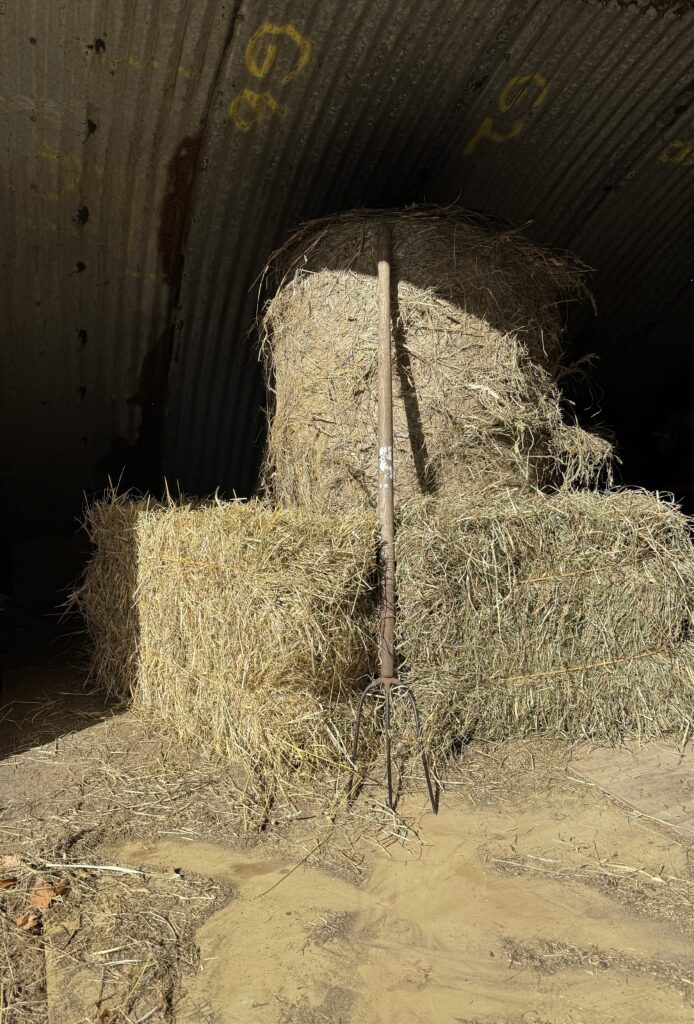By Jacki Martinez Perkins, Organic Dairy and Livestock Specialist
There’s no way around it: At some point in Maine’s cyclical seasons, the grass stops growing and goes dormant. The need to feed hay to our herbivorous livestock during this time is crucial, and knowing what your needs are and what you’re buying is essential to good management.

The most accurate way of determining how much hay to buy is with a little mathematics and knowing how much dry matter your critter needs to eat. Dry matter (DM) is the weight of dry forages, similar to what would be left over after dehydration. For example, dry hay is around 90% dry matter with the remaining 10% being things like dust. For comparison, pastures tend to be anywhere from 15-30% dry matter — very wet.
In the spirit of not running out of feed, do calculations that will cover six months’ worth of feeding a forage-only diet. Don’t complicate the matter with grain intake. Just for fun, let’s use goats as an example, since they tend to be the most discriminating hay critics of all domesticated livestock. A large goat will eat 10 pounds of dry matter a day. If you’re buying 50-pound square bales, each bale will feed one goat for four and half days. The equation for calculating this is as follows: weight of hay x dry matter percentage = weight of dry matter in hay (50-lb. bale x 0.90 = 45 lb. DM). You would then divide this by the required dry matter of feed per day (45 lb. DM/10 lb. = 4.5 days).
At this point, informed readers will have gotten a hearty laugh. A caprine pastime is forsaking hay that other livestock would readily consider candy. Which brings me to my next topic: hay quality. Making hay is part science, part art, and a healthy helping of luck. It is a balance between letting it grow long enough to have substance while still preserving peak nutrition. Weather and soil type tend to dictate this process. Talented, dedicated hay producers are able to cut hayfields up to four times during Maine’s short summers.
Generally, homesteaders insist on second-cut hay because animals eat it with little waste, and traditional weather patterns allow for those five-day windows of drying time after it is cut. Anyone with dairy animals will argue for the first cutting of hay, if it was harvested in mid-May, but that generally means it was ensiled (fermented). If we consider how our cool-season grasses grow, it gives us a better understanding of why livestock love second-cut hay but make better milk and gain more weight on first-cut.
Early first-cuts of grass are preferred by dairy producers because the high mineral content and energy levels increase milk-fat percentages. However, in Maine, it is very hard to make dry hay in May. Therefore, these early high-quality cuttings are made into round bales and wrapped in plastic to ferment. Care must be taken, however, because improperly ensiled hay can grow clostridium botulinum when pH is greater than 4.5, or feed has come in contact with a decomposing carcass. Horses are most at risk, though ruminants can also suffer from botulism.
If the first cutting has been delayed and made into dry hay, the quality has decreased, but there is potential for using the seed content to rejuvenate pasture paddocks with targeted outdoor feeding. Second-cut hay (and beyond) lacks mineral content and energy but is ultimately highly palatable because of the higher sugar content. Can we really blame the goats for preferring cake over broccoli?
Judicious determination on when and who to feed the different cuttings to is up to the management goals of each individual producer. Is the goal milk or is it meat? How is hay waste being managed? Can our model utilize a variety of species? Where can costs be cut or justified?
This brings me to my last point: the geometry of forage. Hay was originally harvested by hand and piled up in stacks. Exposure to the elements results in a loss of 30-50% of harvest when left outside. Then came mechanization and the square bale. This worked great! Farmers could get more hay packed tightly into haymows, and it acted as an insulating layer for the barn beneath. But, stacking thousands of square bales is costly in terms of labor and time, so round balers were engineered, then round bale wrappers allowed operations without storage options to make ensiled feed. This increased efficiency can be seen in the end price paid out by customers. A 600-pound round bale of organic dry hay sells for around $60 whereas the equivalent in square bales would cost over $100, making the savings significant when feeding over six months of time. However, we return to management. How that hay is being stored and fed plays largely into whether cost savings can be realized. We as managers need to do what we must to keep hay clean and dry until it exits the animal.
Livestock can be a fulfilling endeavor in any situation and educating oneself on their management is perpetually stimulating. The best way to avoid aging is to never stop learning or moving, even in the depths of a raw winter. And, I can say from experience, there’s nothing finer than coming in out of the cold.
This article was originally published in the winter 2024-2025 issue of The Maine Organic Farmer & Gardener.
